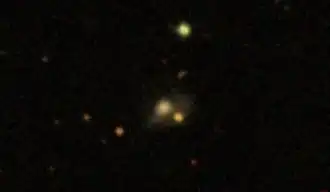IRAS F17179+5444
| IRAS F17179+5444 | |
|---|---|
 SDSS image of IRAS F17179+5444. | |
| Observation data (J2000.0 epoch) | |
| Constellation | Draco |
| Right ascension | 17h 18m 54.38s[1] |
| Declination | +54° 41′ 48.32″[1] |
| Redshift | 0.147680[1] |
| Heliocentric radial velocity | 44,273 km/s[1] |
| Distance | 1.927 Gly |
| Characteristics | |
| Type | ULIRG Sy2[1] |
| Size | ~214,900 ly (65.89 kpc) (estimated)[1] |
| Other designations | |
| 2MASX J17185436+5441486, IRAS 17179+5444, LEDA 165729, TXS 1717+547, CORALZ J171854+544148, SDSS J171854.39+544148.4[1] | |
IRAS F17179+5444 is a Seyfert type 2 galaxy[2] located in the constellation of Draco. The redshift of the object is (z) 0.147[1] and it was first discovered by astronomers in 1994 from the QDOT survey, designated as QDOT 171754.3+544450.[3] It is classified as an ultraluminous infrared galaxy with a star formation rate of 2.29 ± 0.05 Mʘ per year.[4][3][2]
Description
IRAS F17179+5444 is described as a compact galaxy merger. It has a single nucleus, indicating the nuclei have completely coalesced with each other. It is also surrounded by tidal debris with an extension towards the southwest.[5] Hubble Space Telescope continuum imaging shows the morphology of IRAS F17179+5444 to be complex, with two condensation components connected together by a bridge of diffused radio emission in its nuclear region. In the south of the region a long trail of continuum emission is seen emerging towards the southeast of the galaxy's side by 15 kiloparsecs. A series of dust features are seen crossing the nuclear regions of the galaxy.[6]
The galaxy is found to contain a gigahertz-peaked spectrum (GPS) radio source based on Very Long Baseline Interferometry (VLBI) imaging.[2][7] It has two components found having a separation of 68 milliarcseconds when imaged at 1.6 GHz. However, a 5 GHz high-resolution image also showed it has two much weaker components.[8] Observations also found it is a radio-loud object with a power of 1025.23 W Hz-1 and a low frequency turnover.[9][10]
IRAS F17179+5444 has warm ionized outflows. Based on studies, the outflow model of the galaxy is described as having three components; mainly a narrow component, a secondary narrow component and a broad component, being blueshifted by -157 ± 33 kilometers per second, in relation to the narrow component. The broad and narrow components are estimated to have full-width at half maximum measurements of 386 ± 14 and 1,543 ± 34 kilometer per seconds.[11] There is also evidence of compact ionized nuclear outflows in the galaxy. with mass outflow rates of 20.1+72.9-14.9 Mʘ per year, and kinetic power of around 2.5 percent.[9]
References
- ^ a b c d e f g h "NED search results for IRAS F17179+5444". NASA/IPAC Extragalactic Database. Retrieved 2025-08-16.
- ^ a b c Dey, Subhrata; Goyal, Arti; Małek, Katarzyna; Díaz-Santos, Tanio (2024-04-25). "Radio-only and Radio-to-far-ultraviolet Spectral Energy Distribution Modeling of 14 ULIRGs: Insights into the Global Properties of Infrared Bright Galaxies". The Astrophysical Journal. 966 (1): 61. arXiv:2402.10786. Bibcode:2024ApJ...966...61D. doi:10.3847/1538-4357/ad2c93. ISSN 0004-637X.
- ^ a b Leech, K. J.; Rowan-Robinson, M.; Lawrence, A.; Hughes, J. D. (1994-03-15). "Optical structure of a large sample of ultraluminous IRAS galaxies" (PDF). Monthly Notices of the Royal Astronomical Society. 267 (2): 253–269. doi:10.1093/mnras/267.2.253. ISSN 0035-8711.
- ^ Davies, R.I.; Burston, A.; Ward, M.J. (January 2002). "Investigating the central engine of ultraluminous infrared galaxies: near infrared imaging". Monthly Notices of the Royal Astronomical Society. 329 (2): 367–376. Bibcode:2002MNRAS.329..367D. doi:10.1046/j.1365-8711.2002.04990.x. ISSN 0035-8711.
- ^ Veilleux, S.; Kim, D.-C.; Sanders, D. B. (December 2002). "Optical and Near-Infrared Imaging of the IRAS 1 Jy Sample of Ultraluminous Infrared Galaxies. II. The Analysis". The Astrophysical Journal Supplement Series. 143 (2): 315–376. arXiv:astro-ph/0207401. Bibcode:2002ApJS..143..315V. doi:10.1086/343844. ISSN 0067-0049.
- ^ Tadhunter, C; Rodríguez Zaurín, J; Rose, M; Spence, R A W; Batcheldor, D; Berg, M A; Ramos Almeida, C; Spoon, H W W; Sparks, W; Chiaberge, M (2018-05-05). "Quantifying the AGN-driven outflows in ULIRGs (QUADROS) – II. Evidence for compact outflow regions from HST [O III] imaging observations". Monthly Notices of the Royal Astronomical Society. 478 (2): 1558–1569. doi:10.1093/mnras/sty1064. ISSN 0035-8711.
- ^ de Vries, N.; Snellen, I. a. G.; Schilizzi, R. T.; Mack, K.-H.; Kaiser, C. R. (May 2009). "VLBI observations of the CORALZ sample: young radio sources at low redshift". Astronomy and Astrophysics. 498 (2): 641–659. arXiv:0901.2124. Bibcode:2009A&A...498..641D. doi:10.1051/0004-6361/200811145. ISSN 0004-6361.
- ^ Chandola, Yogesh; Sirothia, S. K.; Saikia, D. J. (2011-09-29). "H I absorption towards nearby compact radio sources". Monthly Notices of the Royal Astronomical Society. 418 (3): 1787–1795. arXiv:1108.2242. Bibcode:2011MNRAS.418.1787C. doi:10.1111/j.1365-2966.2011.19607.x. ISSN 0035-8711.
- ^ a b Spence, R A W; Tadhunter, C N; Rose, M; Rodríguez Zaurín, J (2018-05-07). "Quantifying the AGN-driven outflows in ULIRGs (QUADROS) III: measurements of the radii and kinetic powers of eight near-nuclear outflows". Monthly Notices of the Royal Astronomical Society. 478 (2): 2438–2460. doi:10.1093/mnras/sty1046. ISSN 0035-8711.
- ^ Nandi, S.; Das, M.; Dwarakanath, K. S. (June 2021). "Tracing the evolution of ultraluminous infrared galaxies into radio galaxies with low frequency radio observations". Monthly Notices of the Royal Astronomical Society. 503 (4): 5746–5762. arXiv:2102.10600. doi:10.1093/mnras/stab275. ISSN 0035-8711.
- ^ Rodríguez Zaurín, J.; Tadhunter, C. N.; Rose, M.; Holt, J. (June 2013). "The importance of warm, AGN-driven outflows in the nuclear regions of nearby ULIRGs". Monthly Notices of the Royal Astronomical Society. 432 (1): 138–166. arXiv:1303.1400. doi:10.1093/mnras/stt423. ISSN 0035-8711.